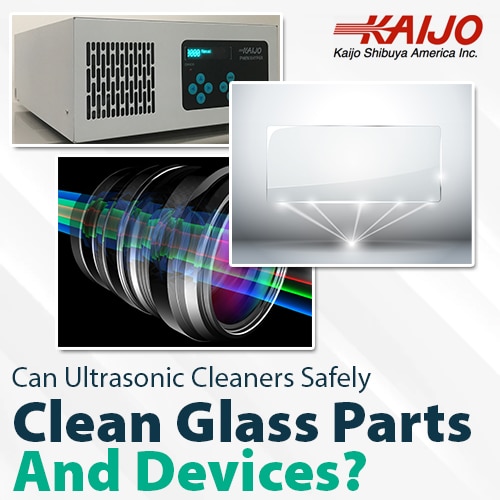Can Ultrasonic Cleaners Safely Clean Glass Parts and Devices?
January 24, 2023
 Most industrial parts and devices that contain glass can be safely and effectively cleaned using ultrasonic cleaners. Ultrasonic cleaning systems can clean glass and other hard surfaces quickly and thoroughly without using harsh chemicals. Glass parts and devices such as flat panels, lenses, viewing ports, test tubes, x-ray tubes, and various kinds of glass containers are ideal candidates for cleaning with ultrasonic systems.
Most industrial parts and devices that contain glass can be safely and effectively cleaned using ultrasonic cleaners. Ultrasonic cleaning systems can clean glass and other hard surfaces quickly and thoroughly without using harsh chemicals. Glass parts and devices such as flat panels, lenses, viewing ports, test tubes, x-ray tubes, and various kinds of glass containers are ideal candidates for cleaning with ultrasonic systems.
For parts made of pure glass, low-frequency ultrasonic cleaners can provide rapid cleaning. Parts made from coated glass may require the gentle cleaning provided by higher ultrasonic frequencies. Glass parts containing other materials or plastics could also be damaged by low-frequency cleaning. An experienced manufacturer of industrial ultrasonic cleaners can help choose cleaning frequencies that match the characteristics of the parts to be cleaned.
How Ultrasonic Frequencies Affect Cleaning Performance
Ultrasonic cleaners use high-frequency sound waves in a cleaning solution to create microscopic cavitation bubbles. The systems comprise a generator, a transducer, and a cleaning tank. The ultrasonic generator produces a high-frequency electric signal, and the transducer converts the signal to ultrasonic sound waves inside the tank. The sound waves create cavitation bubbles as they travel through the cleaning solution.
The size of the cavitation bubbles depends on the frequency of the ultrasonic waves. The waves propagate as alternating areas of high and low pressure. The cavitation bubbles are created in the low-pressure troughs, bursting at the high-pressure peaks. When they burst, they release tiny jets of cleaning solution that remove contamination from the surfaces of the parts to be cleaned.
Frequency Ranges Used in Cleaning Applications
While the bubbles are too small to be seen, low ultrasonic frequencies create comparatively large bubbles, and the resulting jets are powerful enough to damage soft surfaces. Low-frequency ultrasonic cleaners typically operate between 20kHz and 40kHz, and the typical frequencies used are 26kHz and 38kHz. This frequency range provides robust cleaning for hard metals, glass, and porcelain parts. Higher frequency ultrasonic cleaners operate from 78kHz to 200kHz, and the typical frequencies used are 78kHz, 100kHz, 130kHz, 160kHz, and 200kHz. These frequencies deliver gentler cleaning action that will not cause pitting of soft surfaces. Mid-Sonic cleaners operate from 430kHz to 750kHz, and typical frequencies used include 430kHz, and 750kHz. These frequencies provide low-energy cleaning that does not damage even the most fragile components. High Megasonic cleaners operate in the frequency range from 950kHz to 3.0MHz. typical frequencies used are 950kHz, 1.6MHz, 2.0MHz, and 3.0MHz. These frequencies are used for gently removing submicron particles from microstructures.
Cleaning with higher frequencies can take longer, so the type of contamination must be considered. An experienced ultrasonic cleaner manufacturer balances cleaning speed, potential part damage, and contaminant removal to find the optimum solution. When using higher frequencies for delicate parts, cleaning times can sometimes be reduced by heating the cleaning solution or adding a mild detergent or solvent. The type of additive depends on the characteristics of the contaminant to be removed.
How to Ensure Safe Ultrasonic Cleaning of Glass Parts
For safe ultrasonic cleaning, the part materials, coatings, and surface contaminants must be considered. Using high ultrasonic frequencies with plain water in the cleaning tank is the safest solution but probably not the most efficient. Plain glass can be cleaned at lower frequencies, but some glass may be etched if a solvent is added to the cleaning solution. Parts may also be sensitive to temperature if the cleaning solution is heated.
Parts such as lenses are often glass with a coating, or the lens itself may be plastic. Plastics and lens coatings are often sensitive to temperature, and coatings are often soft and easily damaged. For such parts, a room-temperature bath with plain water and a mid-range frequency is typically the most appropriate.
For plain glass parts such as test tubes or glass containers, low-frequency ultrasonic cleaners can be used. If the contaminant is grease or oil, a mild detergent and a heated bath can speed up the cleaning process without damaging the glass. Plain glass is hard enough to resist pitting or damage from the energetic jets of low-frequency cleaners.
Some specialized devices that contain glass may incorporate the use of electronics. Electronics are heat-sensitive, mechanically fragile, and include soft materials. These devices can be cleaned effectively with high-frequency ultrasonic cleaners. The smaller cavitation bubbles and less energetic jets will not damage the electronic components or erode pits into soft surfaces.
While glass parts have hard surfaces, glass can easily break when subjected to stress or impacts. As a result, all glass parts must be correctly placed into the ultrasonic cleaning tank. All parts have to be completely submerged with no air trapped inside the glass or around it. Glass parts should be placed securely into a cleaning tank basket to avoid parts moving around and banging into each other or the tank walls.
Kaijo Can Help Select the Best Ultrasonic Cleaner for Glass Parts
Kaijo has the experience and in-house expertise to help customers with their glass part cleaning applications. As a global leader in ultrasonic technology, Kaijo designs and builds ultrasonic cleaning systems for various industrial applications. In addition to their complete line of ultrasonic cleaners, Kaijo can supply ultrasonic cleaning components for integration into existing production lines.
Kaijo can recommend the best system frequencies, power, transducers, and tank configuration for specific cleaning applications, including glass parts. Contact Kaijo for a free consultation to discuss which ultrasonic cleaner should be used for your specific application.





